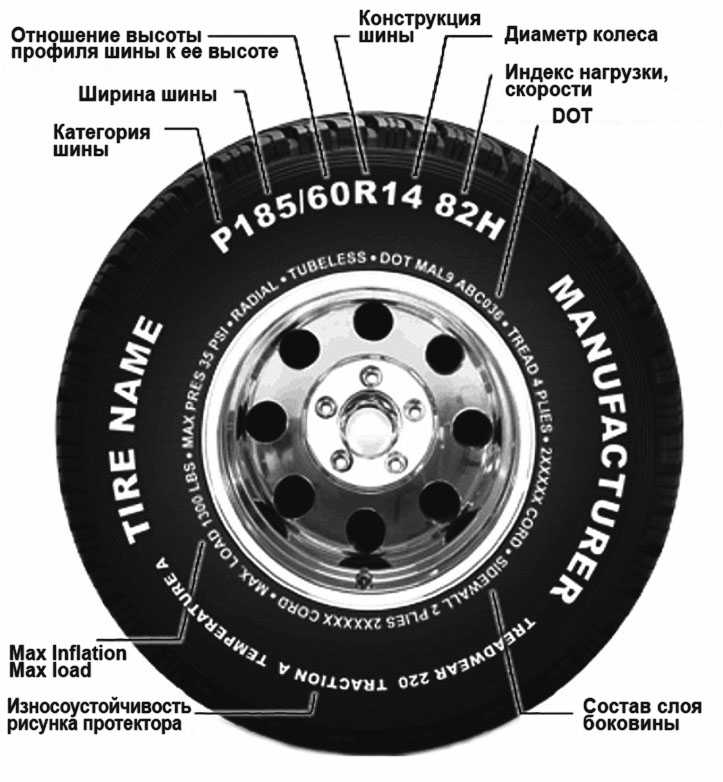What do the numbers mean on the sidewall of your tire? At first glance, you look at your tire sidewall and think, “’Do I need a super secret decoder ring to read this?” In addition to the model name of the tire there is a series of numbers that at first, you don’t deem important. However, these numbers are extremely helpful, especially when it’s time to replace your tires. Here’s a quick breakdown to help you decipher one of the best kept secrets in the automotive world: How do you read tire sizes?
TIRE SIZE
Example: P225/50/R17 98H
P identifies your tire as a Passenger Tire. The P stands for PMetric. If your tire size starts with LT rather than a P than it identifies the tire as a Light Truck tire.
225 identifies the tire section width, which is the measurement of the tire from sidewall to sidewall in millimeters. This measurement varies depending on the rim to which it is fitted.
(There are 25.4 millimeters per 1 inch.)
50 is the two-figure aspect ratio. This percentage compares the tire's section height with the tire's section width. For example, this aspect ratio of 50 means that the tire's section height is 50% of the tire's section width.
R indicates the construction used within the tires casing. R stands for radial construction. B means belted bias and D stands for diagonal bias construction.
17 The last dimension listed in the size is the diameter of the wheel rim, which is most often measured in inches.
LOAD INDEX AND SPEED RATING
Example: P225/50/R17 98H
The load index and speed rating, or service description, are the numbers that follow the tire size.
The load index tells you how much weight the tire can support when properly inflated. Load indices range from 75 - 105 for passenger tires, with each numeric value corresponding to a certain carrying capacity.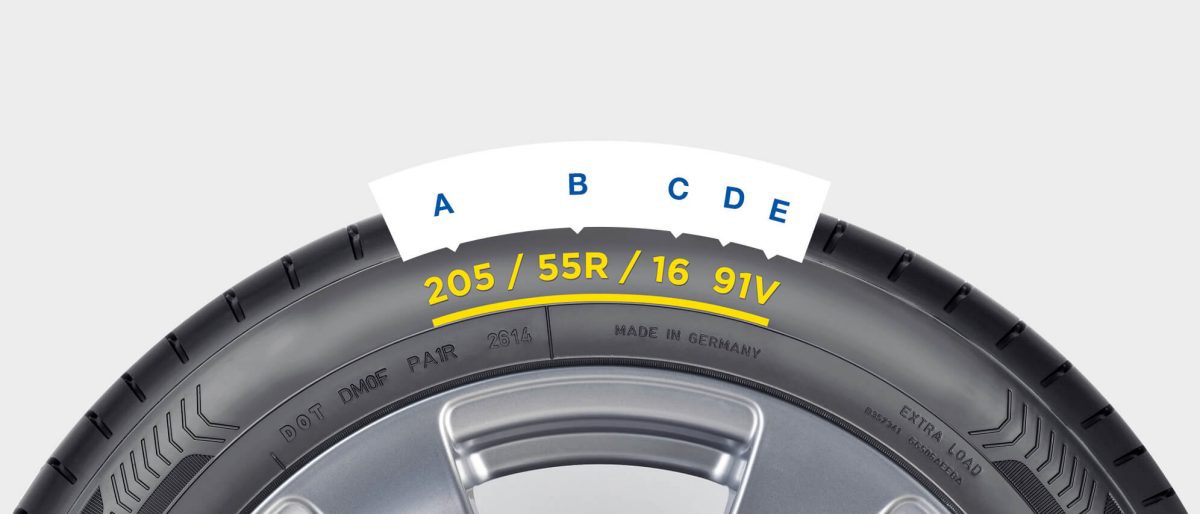 The carrying capacity for each value can be found on a load index chart. On each U.S. passenger car tire, the load limit is listed in pounds. European tires have the load limit listed in kilograms and sometimes pounds.
The carrying capacity for each value can be found on a load index chart. On each U.S. passenger car tire, the load limit is listed in pounds. European tires have the load limit listed in kilograms and sometimes pounds.
H Speed ratings are represented by letters ranging from A to Z. Each letter coincides to the maximum speed a tire can sustain under its recommended load capacity. For instance, S is equivalent to a maximum speed of 112 mph. Even though a tire can perform at this speed, Continental Tire does not advocate exceeding legal speed limits.
Rating | Maximum Speed |
Q | 100 MPH |
S | 112 MPH |
T | 118 MPH |
U | 124 MPH |
H | 130 MPH |
V | 149 MPH |
W | 168 MPH |
Y | 186 MPH |
Z | Over 149 MPH |
DOT Serial Number
The "DOT" symbol certifies the tire manufacturer's compliance with the U.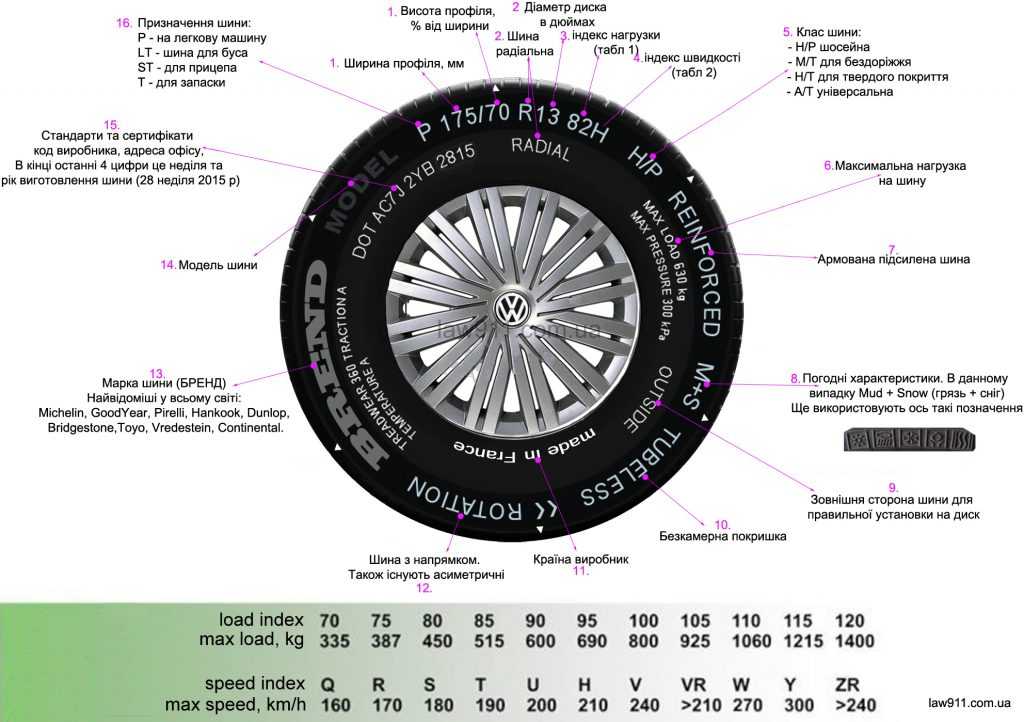 S. Department of Transportation (DOT) tire safety standards. Tires made in the United States have the DOT serial number located on the inside sidewall near the rim.
S. Department of Transportation (DOT) tire safety standards. Tires made in the United States have the DOT serial number located on the inside sidewall near the rim.
Below is a description of the serial number. Starting with the year 2000, four numbers are used for the Date of Manufacture, the first two numbers identify the week and the last two numbers identify the year of manufacture. This identifies how old a tire is.
Prior to year 2000 three numbers are used for the date of manufacture, first two numbers identify the week and the last number identifies the year of manufacture. To identify tires manufactured in the 90s, a decade symbol (a triangle on its side) is located at the end of the DOT serial number.
Want to know how old your tires are or what size your tires are? You need to know how to read tire sidewall information, the alphanumeric code stamped on to the side of your tires. But if you've ever looked at the sidewall of a tire and thought that the blizzard of numbers, letters, and words was as confusing as hieroglyphics, we understand.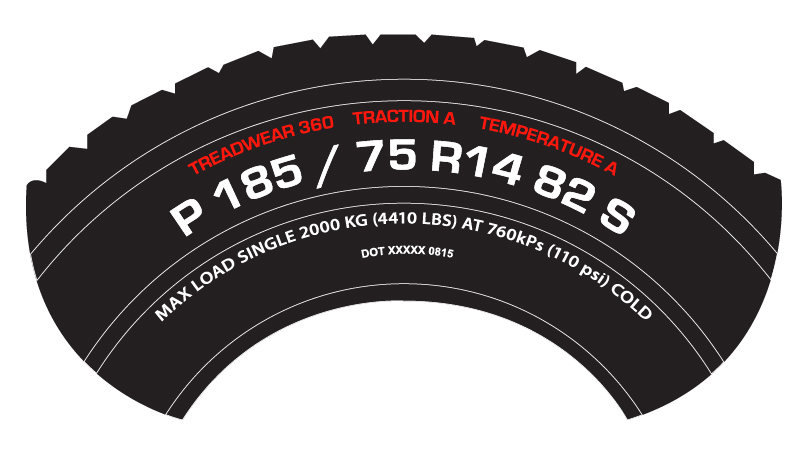 The alphabet soup on tires' sidewalls can be off-putting, but it's pretty easy once you know what you're looking at.
The alphabet soup on tires' sidewalls can be off-putting, but it's pretty easy once you know what you're looking at.
Beyond the brand (Michelin, Continental, Hankook, etc.) and model names of the tire, the plethora of data stamped on the sidewall is there largely to satisfy government regulations, which require all manner of information—from when and where the tire was built to how durable it is. Not to worry. Let us be your Rosetta stone to deciphering the language of the tire sidewall. The numbers highlighted in pink on the sample tire below correspond to the explanations that follow.
1) These are some of the most important numbers on any tire, as they tell you how big your tires are. In this case, the tire is 245 millimeters at its widest point (when it's mounted on a wheel of a specified width).
2) The number after the slash indicates its aspect ratio, or profile. This tire's sidewall height is 40 percent of its width.
3) The "R" stands for radial construction (rarer bias-ply and belted tires are denoted by a D and B, respectively).
4) The number 18 indicates that this tire fits an 18-inch wheel. Sometimes, letters precede the first number. A "P" stands for p-metric, which is a tire used primarily on passenger cars. An "LT" indicates a light-truck tire. A "T" means it's a temporary spare. Some tires get a "Z" or an "F" attached to the radial indicator, denoting a Z-rated tire (see service description below) or a run-flat tire.
5) This alphanumeric code is the service description, which provides two key insights into the tire's performance: how much weight it can carry and how fast it can run safely—the latter another good indication of whether it's intended for a family sedan or a hot sporty machine. In our example, the "93" stands for the maximum-load rating of 1433 pounds. The letter W denotes the maximum speed rating, which translates 168 mph—not something intended for mom's minivan.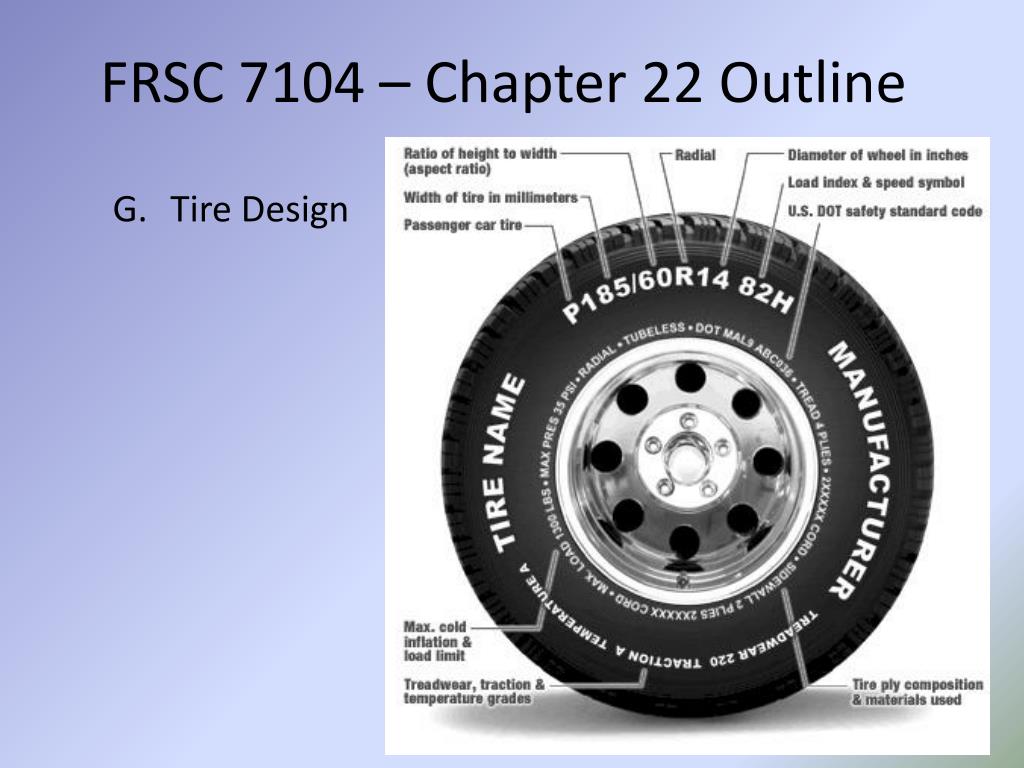 See our list of speed ratings below, which range from a low of "L" (just 75 mph for some off-road tires) to a high of Y (186 mph). There is also one special ultrahigh speed rating: If a Y-rated tire has parentheses around its service description, say, "(93Y)," that means the tire is rated for speed "in excess of 186 mph." There are also Z-rated tires, but when that designation came out, no one thought a speed rating in excess of 149 mph would ever be needed. By definition, all W- and Y- rated tires are also Z-rated, though not all get a "Z" embossed on the sidewall.
See our list of speed ratings below, which range from a low of "L" (just 75 mph for some off-road tires) to a high of Y (186 mph). There is also one special ultrahigh speed rating: If a Y-rated tire has parentheses around its service description, say, "(93Y)," that means the tire is rated for speed "in excess of 186 mph." There are also Z-rated tires, but when that designation came out, no one thought a speed rating in excess of 149 mph would ever be needed. By definition, all W- and Y- rated tires are also Z-rated, though not all get a "Z" embossed on the sidewall.
6) Many but not all tiremakers note the heaviest spot of the tire with a red dot.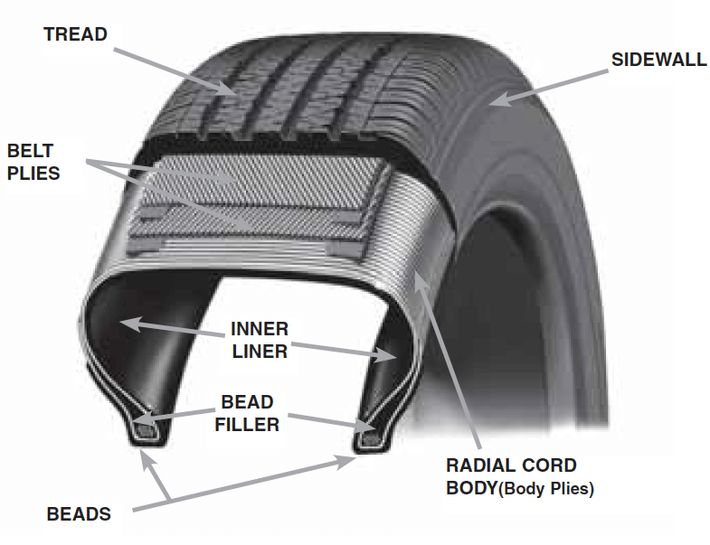 It ultimately has no bearing on tire-and-wheel balance, so it's of little importance.
It ultimately has no bearing on tire-and-wheel balance, so it's of little importance.
A tire's alphanumeric codes reveal everything from how fast it can run to where it was built.
7) The numbers after the word "treadwear" indicate (surprise!) the treadwear of the tire, or how long it's likely to last. The higher the number, the more likely it is that you'll get more miles out of it. But the tests that determine tread life are not exact. The experts at tire-seller Tire Rack report that treadwear ratings can vary. They cite the example of two different tires they sell—one from Goodyear and the other from Continental—both of which offer an 80,000-mile tread-life warranty. You'd expect them to have similar, if not identical, treadwear ratings, but the Goodyear's is 740, while the Continental's is 600. So take this number as an indicator, but not an exact predictor, of how long a tire will last.
8‑9) The letter after the word "traction" is a rating that results from a test of how much grip a tire generates when dragged across wet pavement without the tire rotating. It's not of great relevance to today's cars, which have anti-lock brakes that keep the tires rolling even during emergency braking. The letter following the word "temperature" is an indicator of how well a tire dissipates heat, which increases severely at high speed. Again, it is of less importance than the tire's speed rating, which takes this into account.
It's not of great relevance to today's cars, which have anti-lock brakes that keep the tires rolling even during emergency braking. The letter following the word "temperature" is an indicator of how well a tire dissipates heat, which increases severely at high speed. Again, it is of less importance than the tire's speed rating, which takes this into account.
10‑11) Some tires carry an "M+S" marking, which stands for "mud and snow." It means that the tire has some added capability in those circumstances because it has a little extra space between its tread blocks. But such tires are absolutely not winter (snow) tires and might not even be conventional all-season tires. That's where the three-peak mountain snowflake icon next to the M+S mark comes in. If a tire has that molded into its sidewall, it has significant snow capability and should be considered a viable winter tire.
12) This area of the tire may display what's called the original-equipment (OE) marking. Automakers sometimes take a standard, off-the-rack commodity tire and modify its construction or rubber compound to work better on one of their models. So, a Ford Escort and a Chevy Cruze might both be equipped with Firestone Firehawk AS tires that look virtually identical, but each car's tires might differ significantly in ways that affect the ride and handling. If your vehicle's tires carry an OE code, it's best to replace them with the same brand and model of tire wearing the same code—if you can. Tire stores and online retailers can help you with finding tires with the correct OE code for your vehicle.
Automakers sometimes take a standard, off-the-rack commodity tire and modify its construction or rubber compound to work better on one of their models. So, a Ford Escort and a Chevy Cruze might both be equipped with Firestone Firehawk AS tires that look virtually identical, but each car's tires might differ significantly in ways that affect the ride and handling. If your vehicle's tires carry an OE code, it's best to replace them with the same brand and model of tire wearing the same code—if you can. Tire stores and online retailers can help you with finding tires with the correct OE code for your vehicle.
13) This is a list of the tire's construction materials, of interest primarily to tire engineers and tire geeks.
14) Every tire sold in the U.S. must have U.S. Department of Transportation (DOT) labeling. The first two characters indicate the factory of manufacture, and the next five or six are manufacturer-specific jargon (for tracking purposes, as in the case of a recall).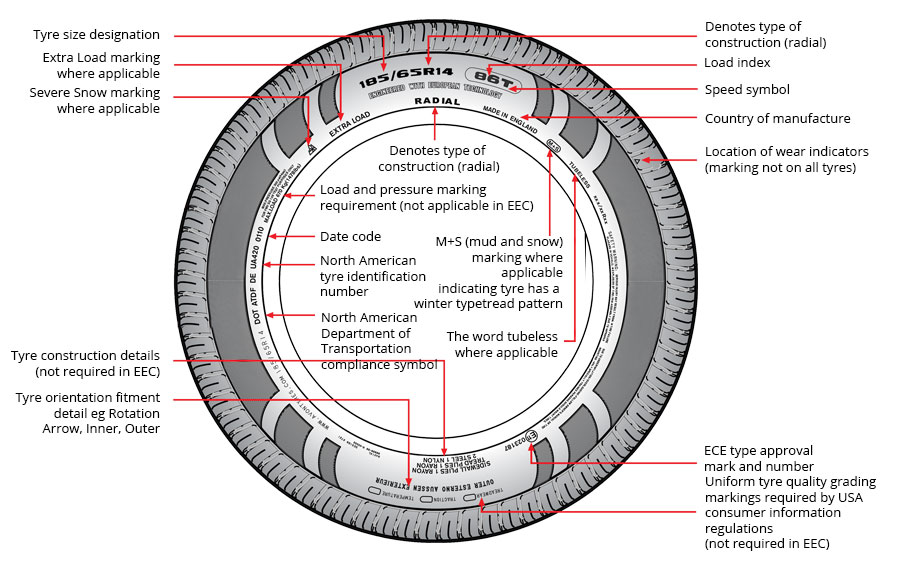 The last four numbers give the date of production which let you know how old your tires are with the first two digits indicating the week and the latter two the year (for example, "2318" means that tire was produced in the 23rd week of 2018). The European equivalent of the DOT code may also be present (it starts with an "e"), although fewer manufacturers are printing both on a tire's sidewall. If this string of numbers ends with "-S," it means the tire complies with European noise regulations.
The last four numbers give the date of production which let you know how old your tires are with the first two digits indicating the week and the latter two the year (for example, "2318" means that tire was produced in the 23rd week of 2018). The European equivalent of the DOT code may also be present (it starts with an "e"), although fewer manufacturers are printing both on a tire's sidewall. If this string of numbers ends with "-S," it means the tire complies with European noise regulations.
Tire Rack
Buy Now
Tire Rack
Buy Now
Tire Rack
Buy Now
Tire Rack
Buy Now
The alphanumeric code on the sidewall of the tire (unless, of course, it's a Bridgestone airless concept - there's no sidewall either) tells the product's characteristics.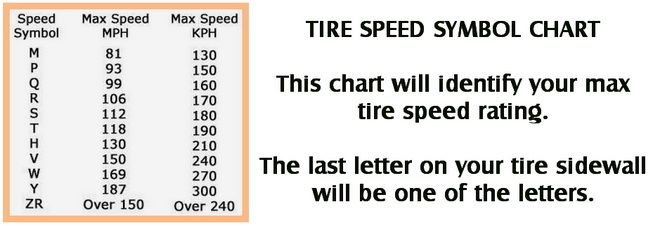 Information is needed to know for which wheel the tire is suitable, with what maximum speed it can be driven, whether the rubber is intended for winter or can be driven in summer.
Information is needed to know for which wheel the tire is suitable, with what maximum speed it can be driven, whether the rubber is intended for winter or can be driven in summer.
The marking under the number 1 in the picture indicate the size of the tire and its classification by load capacity. This "magic of numbers and symbols" may be preceded by the Latin letters "P" (P-metric, as a rule, used for cars, from English - Passenger Vehicle), "LT" (metric of light freight transport, from English - Light Truck ), or "T" (spare, from English - Temporary Spare). If none of these letters is in front of the symbols, then the tire was smelted according to European metric standards. For the end user, there is no valuable information in the letters. Car tires marked "P", "LT" and simply without the "P" symbol are interchangeable, although the "LT" has a higher load capacity than the "P", as well as the ability to use in conditions where the internal pressure in the wheel can increase dramatically (sport tires).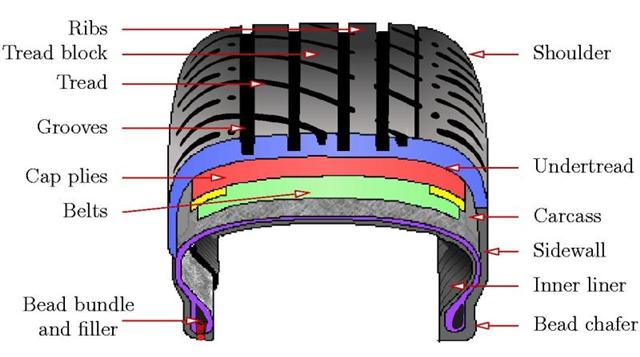 The number in the picture "225" means the width of the profile in millimeters, the two-digit number "40" following it is the ratio of the height of the side wall of the rubber to the width of the section. The following letter(s) describes the design of the tire: R for radial tires, ZR for Z-rated radials, there is a ZRF marking for Z-rated flat tires, but these are rarely used. The last two-digit number in the picture is "18", indicating the diameter of the wheel. The diameter is indicated in inches. Read a detailed analysis of the design of automotive rubber here.
The number in the picture "225" means the width of the profile in millimeters, the two-digit number "40" following it is the ratio of the height of the side wall of the rubber to the width of the section. The following letter(s) describes the design of the tire: R for radial tires, ZR for Z-rated radials, there is a ZRF marking for Z-rated flat tires, but these are rarely used. The last two-digit number in the picture is "18", indicating the diameter of the wheel. The diameter is indicated in inches. Read a detailed analysis of the design of automotive rubber here.
The last four digits of the DOT code printed on the tire sidewall indicate the week of the year in which the tire was rolled off the assembly line. For example, if the wheel was made in 2011 on New Year's Eve, then the last digits would be "5211". The rest of the numeric value (which precedes the digit representing the week of the build year) is essentially meaningless to consumers.
Why do you need to know when the tire was made? Even tires lying alone in the garage lose their properties. When buying new tires on Avito, look at the production date. We do not recommend taking tires for a period of more than 10 years from the date of manufacture.
When buying new tires on Avito, look at the production date. We do not recommend taking tires for a period of more than 10 years from the date of manufacture.
This marking indicates for which brand of car the tire is intended. The pointer is important because the material formulation, the construction system, as well as many other factors in the wheels assembled for a particular car model, differ from the classic tires sold in stores. N0, N1, N2, N3, N4 are tires smelted for Porsche, the five-pointed star is BMW, M0 is Mercedes, K1 is Ferrari, TPS SPEC is GM.
This pictogram indicates that the wheel meets the US Rubber Manufacturers Association and Canadian Rubber Manufacturers Association snow traction requirements (relevant for tires shipped from America). Nobody installed a snowflake icon to designate winter tires in Russia, but the meaning of the designation is clear.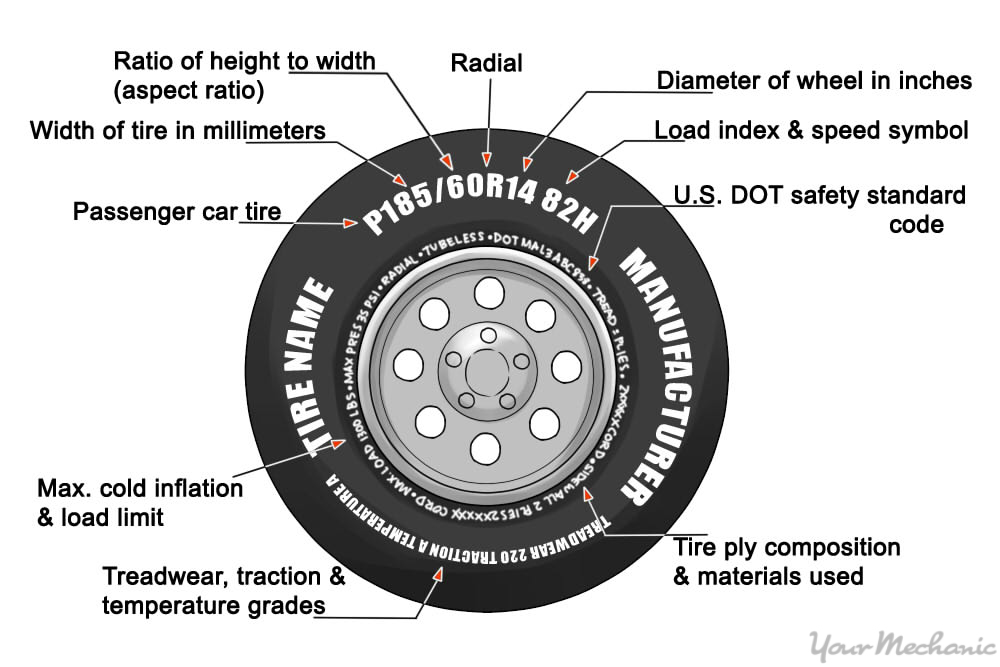
This marking may look like MS, M/S, M&S or M+S. It means "mud and snow" (mud and snow). The M+S marking on the sidewall indicates all-season tires. In winter weather, they lose to a real winter tire and are more suitable for a climate where the car kneads mud during the day and snow and ice at night. Rating dissimilar wheels for different purposes here.
This is a standardized wear and grip rating. Marking is required for tires sold in the United States. A higher number indicates that the rubber will last longer than a rubber with a low number. The letters following the number indicate the relative thrust and temperature level: A is better than B, and so on. These are standard data, which are only an approximate guideline for us, so you should not pay attention to them.
"93W" in the picture refers to the tire's load capacity or "load bearing capacity index". The larger the number, the higher the load capacity for which the tire is designed. The letter is an indicator of speed. The lowest L value is the maximum speed for such tires 120 km/h. Ordinary urban models are rolled off the assembly line wearing rubber with a speed marking of S - 180 km / h, or higher. Rubber with a Z marker will withstand speeds of more than 240 km/h. Over the past 30 years, the maximum capabilities of cars have increased, which led to the appearance of W and Y markers, the maximum speed of which is 270 and 300 km / h, respectively. If the letters W and Y are enclosed in brackets, then on such tires you can accelerate above 270 and 300 km / h. Since wheels marked W and Y are rated for more than 240 km/h, they are included in the Z-tire rating, although this marking is often omitted. An analysis of the best high-speed tires is here.
The larger the number, the higher the load capacity for which the tire is designed. The letter is an indicator of speed. The lowest L value is the maximum speed for such tires 120 km/h. Ordinary urban models are rolled off the assembly line wearing rubber with a speed marking of S - 180 km / h, or higher. Rubber with a Z marker will withstand speeds of more than 240 km/h. Over the past 30 years, the maximum capabilities of cars have increased, which led to the appearance of W and Y markers, the maximum speed of which is 270 and 300 km / h, respectively. If the letters W and Y are enclosed in brackets, then on such tires you can accelerate above 270 and 300 km / h. Since wheels marked W and Y are rated for more than 240 km/h, they are included in the Z-tire rating, although this marking is often omitted. An analysis of the best high-speed tires is here.
We are committing an unforgivable mistake by not paying attention to the labels stuck on tires. Some models of Toyo and Yokohamas tires are marked with temporary stickers that warn about the peculiarities of using the product. Such Toyo and Yokohamas models are strictly forbidden to be used or installed in low temperatures - for Toyo it is -9 degrees Celsius, for Yokohamas it is -10 degrees Celsius. These tire models are subject to a phenomenon known as "cold joint cracking", which occurs when the temperature in the rubber walls drops below the glass transition point of the joint, and any amount of deflection, even the lowest, is contraindicated in the rubber. Ignorance of this feature will lead to microcracks or torn rubber.
Some models of Toyo and Yokohamas tires are marked with temporary stickers that warn about the peculiarities of using the product. Such Toyo and Yokohamas models are strictly forbidden to be used or installed in low temperatures - for Toyo it is -9 degrees Celsius, for Yokohamas it is -10 degrees Celsius. These tire models are subject to a phenomenon known as "cold joint cracking", which occurs when the temperature in the rubber walls drops below the glass transition point of the joint, and any amount of deflection, even the lowest, is contraindicated in the rubber. Ignorance of this feature will lead to microcracks or torn rubber.
Do you want to choose a tire for your car, but do not understand tire markings well? It's not a problem! In this section, we will help you figure out what tire parameters are, what they mean, and which tire is right for your car.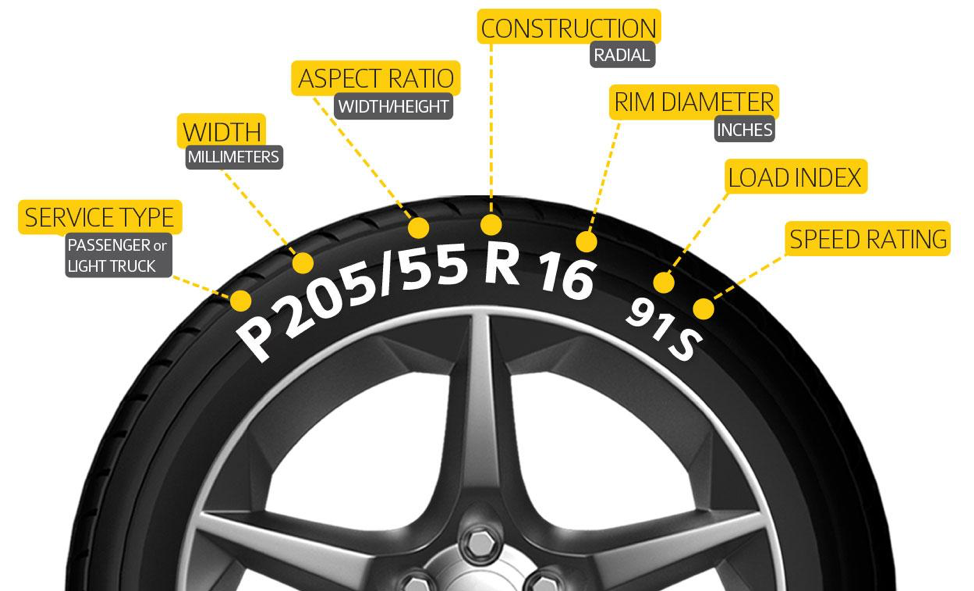
195/65 R15 91 T XL
195 is the tire width in mm.
65 - Proportionality, i.e. profile height to width ratio. In our case, it is equal to 65%. Simply put, with the same width, the larger this indicator, the higher the tire will be and vice versa. Usually this value is simply called “profile”.
Since the tire profile is a relative value, it is important to consider when choosing rubber that if you instead of size 195/65 R15, if you want to put tires with a size of 205/65 R15, then not only the width of the tire will increase, but also the height! Which in most cases is unacceptable! (except when both of these sizes are indicated in the car's operating book). You can calculate the exact data on changing the outer dimensions of the wheel in a special tire calculator.
If this ratio is not specified (for example, 185/R14C), then it is equal to 80-82% and the tire is called full profile. Reinforced tires with this marking are usually used on minibuses and light trucks, where a large maximum wheel load is very important.
Reinforced tires with this marking are usually used on minibuses and light trucks, where a large maximum wheel load is very important.
R - means a tire with a radial cord (in fact, almost all tires are made this way now).
Many mistakenly believe that R- means the radius of the tire, but this is precisely the radial design of the tire. There is also a diagonal design (indicated by the letter D), but recently it has practically not been produced, since its performance is noticeably worse.
15 - wheel (rim) diameter in inches. (It is the diameter, not the radius! This is also a common mistake). This is the “landing” diameter of the tire on the disk, i.e. is the inside size of the tire or the outside of the rim.
91 - load index. This is the level of maximum permissible load on one wheel. For passenger cars, it is usually done with a margin and is not a decisive factor when choosing tires (in our case, IN - 91 - 670 kg.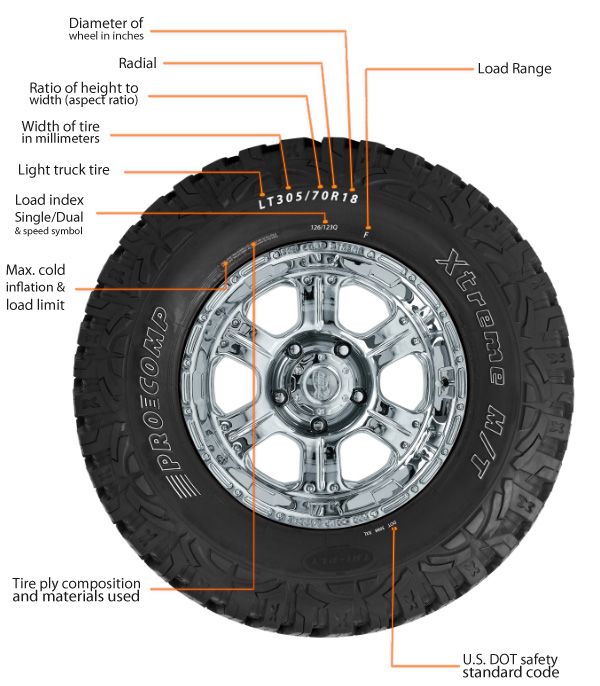 ). For minibuses and small trucks, this parameter is very important and must be observed.
). For minibuses and small trucks, this parameter is very important and must be observed.
T is the tire speed index. The larger it is, the faster you can ride on this tire (in our case, IS - H - up to 210 km / h). Speaking about the tire speed index, I would like to note that with this parameter, the tire manufacturer guarantees the normal operation of the rubber when the car is constantly moving at the specified speed for several hours.
There are two different markings for American tires. The first one is very similar to the European one, only the letters “P” (Passanger - for a passenger car) or “LT” (Light Truck - light truck) are placed before the size. For example: P 195/60 R 14 or LT 235/75 R15. And another tire marking, which is fundamentally different from the European one.
Example: 31x10. 5 R15 (corresponds to European size 265/75 R15)
5 R15 (corresponds to European size 265/75 R15)
31 is the outside diameter of the tire in inches.
10.5 is tire width in inches.
R - a tire with a radial design (older tire models were with a diagonal design).
15 is the inner diameter of the tire in inches.
Generally speaking, except for inches that are unusual for us, the American tire marking is logical and more understandable, unlike the European one, where the height of the tire profile is not constant and depends on the width of the tire. And here everything is simple with decoding: the first digit of the standard size is the outer diameter, the second is the width, the third is the inner diameter.
XL or Extra Load is a reinforced tire with a load index that is 3 points higher than conventional tires of the same size.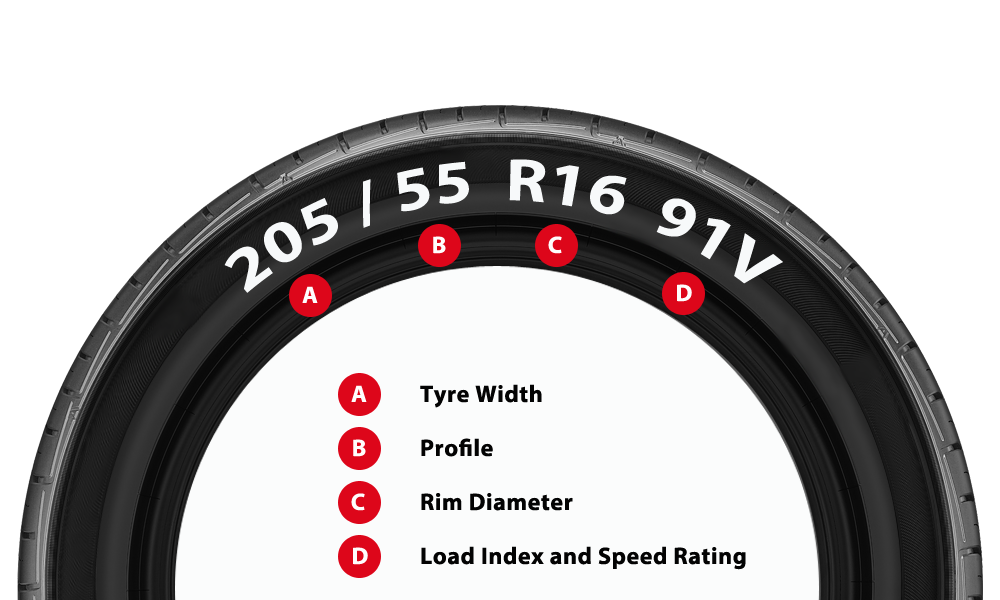 In other words, if a given tire has a load index of 91 marked XL or Extra Load, then this means that with this index, the tire is able to withstand a maximum load of 670 kg instead of 615 kg (see the table of tire load indices).
In other words, if a given tire has a load index of 91 marked XL or Extra Load, then this means that with this index, the tire is able to withstand a maximum load of 670 kg instead of 615 kg (see the table of tire load indices).
M+S or M&S tire marking (Mud + Snow) - mud plus snow and means that the tires are all-season or winter. Many summer tires for SUVs are labeled M&S. However, these tires must not be used in winter, as winter tires have a completely different rubber compound and tread pattern, and the M&S badge indicates good flotation performance.
All Season or AS all season tires. Aw (Any Weather) - Any weather.
Pictogram * (snowflake) — rubber is designed for use in harsh winter conditions. If this marking is not on the sidewall of the tire, then this tire is intended for use only in summer conditions.
Aquatred, Aquacontact, Rain, Water, Aqua or pictogram (umbrella) - special rain tires.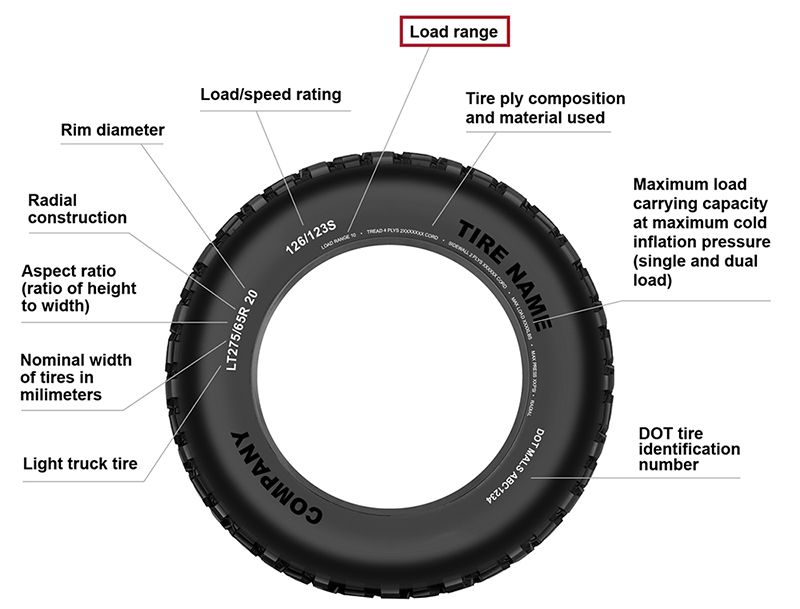
Outside and Inside ; asymmetric tires, i.e. It is important not to confuse which side is the outside and which is the inside. When installing, the Outside inscription must be on the outside of the car, and Inside on the inside.
RSC (RunFlat System Component) - RunFlat tires are tires on which you can continue to drive a car at a speed of no more than 80 km / h with a FULL loss of pressure in the tire (due to a puncture or cut). On these tires, depending on the manufacturer's recommendations, you can drive from 50 to 150 km. Different tire manufacturers use different designations for RSC technology. For example: Bridgestone RFT, Continental SSR, Goodyear RunOnFlat, Nokian Run Flat, Michelin ZP etc.
Rotation or arrow This marking on the tire sidewall indicates a directional tire. When installing the tire, you must strictly observe the direction of rotation of the wheel, indicated by the arrow.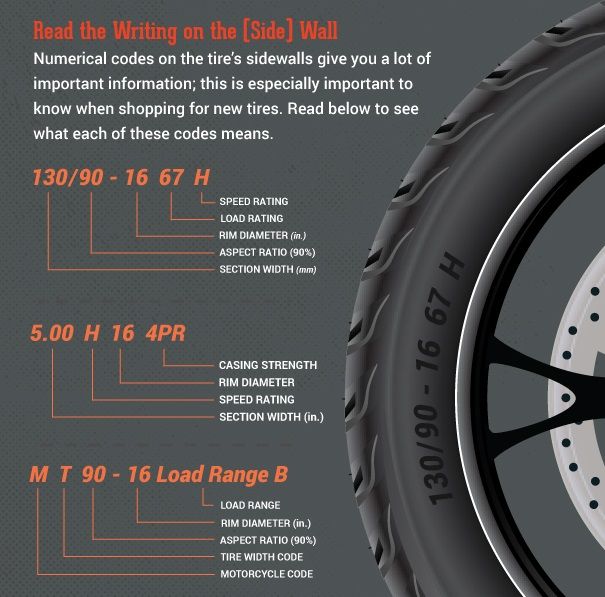
Tubeless - tubeless tire. In the absence of this inscription, the tire can only be used with a camera. Tube Type - indicates that this tire must be used only with a tube.
Max Pressure ; maximum allowable tire pressure. Max Load - the maximum allowable load on each wheel of the car, in kg.
Reinforced or the letters RF in the size (for example 195/70 R15RF) means that this is a reinforced tire (6 layers). The letter C at the end of the size (for example 195/70 R15C) indicates a truck tire (8 layers).
Radial this marking on the rubber in the standard size means that this is a radial construction tire. Steel means that there is a metal cord in the tire structure.
Letter E (in a circle) - the tire meets the European requirements of ECE (Economic Commission for Europe). DOT (Department of Transportation - US Department of Transportation) is an American quality standard.
Temperature A, B, or C The temperature resistance of the tire at high speeds on the test stand (A is best).